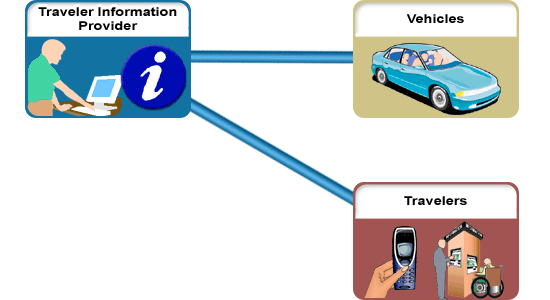Application Areas
Traveler Information
Description
This center-to-vehicle/traveler application area covers the interfaces between traveler information providers and the devices used by the traveling public. Travelers may access the information either pre-trip or en route using equipment within a vehicle, a personal computer (or personal handheld device), a public kiosk, or equipment at a transit stop or transit facility. Information exchanges, whether personalized or broadcast to the general public, support the following:- General traveler information, including traffic information, transit information (fares, real-time schedules, and transactions), incident information, event information, and parking information
- Emergency traveler information, including alerts and advisories, and evacuation information.
- Traveler services information (e.g., dining, lodging, etc.)
- Trip planning, using various modes of surface transportation and route options
- Route guidance

National ITS Architecture Interface
This application area includes the interfaces between the Information Service Provider (ISP) and the driver/traveler, and also between the Transit Management Subsystem (TRMS) and the transit traveler. Traveler information can be disseminated by the ISP to a driver in a vehicle (Vehicle Subsystem). The traveler information can also be disseminated to a traveler at a kiosk (Remote Traveler Support, or RTS), or via handheld devices or computers (Personal Information Access Subsystem, or PIAS). This information includes congestion maps, link travel times, event information (e.g., incidents), road closures, etc. Other requested information could include yellow pages, and general tourism information. Traveler information could be broadcast, and hence be more general in nature, or personalized for a traveler (or vehicle driver) based on his or her location, personal transportation mode preferences, and other customizations. Personalized traveler information could, for example, include specific route travel times, route guidance, notification of incidents along route, reservations and trip planning (both requests and confirmations). The Transit Management Subsystem can provide transit information such as schedules, adherence, fare information to transit users either pre-trip or en route. Pre-trip information could be via the PIAS. En route information could be via kiosk or at instrumented transit stops or transit facilities (RTS). There is also the option to provide traveler information onto a transit vehicle; this is covered in the Transit Vehicle Communications application area.Applicable Standards
In general, the following standards are applicable to Traveler Information deployments. To determine which specific standards are applicable for a deployment you will need to determine which architecture flows will be needed for the Traveler Information piece of your deployment. Contact your local FHWA ITS Division Specialist or an ITS Standards Program Field Support Team contact
Deployment Resources
Deployment resources can be found in the deployment resources
section.